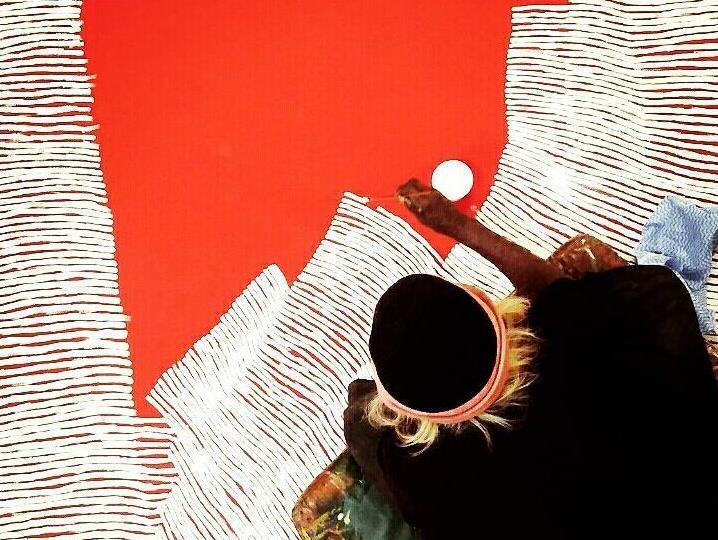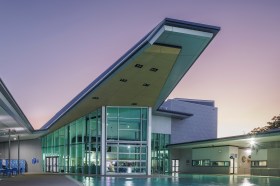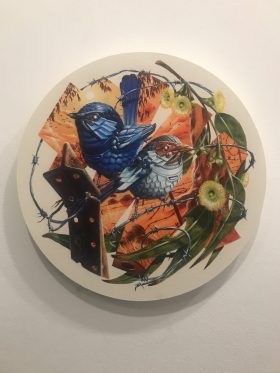Image: Ikuntji Artists. In the studio with Eunice Napanangka Jack.
Indigenous arts professionals working in remote locations across central Australia, South Australia and the Northern Territory are working towards a more resilient future for Indigenous arts. Here are their thoughts on where the sector needs to grow and what’s working.
1. The need for more investment
Desart CEO Philip Watkins said the sector needs continued investment – from both the private and public arenas: ‘In particular, investment (physical, financial, political) to ensure Indigenous cultural expressions are able to be supported and presented in ways that enable artists and art centres in our region to participate fully in the arts sector, whilst at the same time realising the enormous benefits and opportunities that exist.’
Read: Why an outback arts manager could be your dream job
2. Art Centres are evolving
While the future looks strong, it will not be without its challenges. Fortunately, art centres are evolving new business models to meet these challenges head on.
‘There is investment in younger emerging artists being supported and promoted, whilst focus on major projects and commissions are being supported by festivals across the country and internationally,’ Watkins said.
He noted an exciting increase in experimentation with new mediums, particularly in the space of multi-media projects by a new generation of artists.
‘Indigenous culture and lived contemporary experience will continue to inform art making in the future. We also have a strong desire from elders to support young people taking on different administrative and studio roles (as distinct from being artists) and we will see more agency from community art centres in directing and fulfilling their artistic and cultural aspirations.’
3. Increased focus on artists’ development
Melanie Sarantou, Manager of Tjutjuna (Ceduna) Arts and Culture Centre, agreed that art centres have an increasingly important role to play in the future of Indigenous arts. But she wants to see this role grow to include more artists’ development.
‘The development of the artist happens within these art centres mainly. There are quite a few strong visual artists around who don’t necessarily need this infrastructure, but if the art centres are run with a focus of bringing the unknown artist into the industry and giving them the right guidance and opportunity to enter art as a professional practice – I’m thinking of people like Beaver Lennon and Ashley Pompey who are both really brilliant young artists – careers can be shaped through the activities of an art centre.
‘The art centre offers that infrastructure and support for these artists to take baby steps. We encourage participation in art prizes, we market the artists and their work internationally and regionally, we organise exhibitions.’
Read: Transforming a regional arts centre
4. Growing the international art market
‘A lot of the art centres have achieved incredible international acknowledgement and there really is strong interest in Aboriginal art worldwide. It is appreciated by art galleries and museums internationally,’ said Sarantou.
But Sarantou’s future hope for Tjutjuna Arts is to see that potential market explored further. ‘Much more aggressive international arts marketing is what I want to see from our art centre.’
5. We can expect more stories
Museum and Art Gallery Northern Territory (MAGNT) Aboriginal Art Curator Luke Scholes said: ‘The future of the sector is likely to continue to diversify … not just in the medium the artists are working in but in the issues, the stories and their identity, which they continue to confront.
‘We have had I suppose, in the past, artists really look at personal identity and belonging and cultural and ancestral past and now I think we have a group of artists – particularly those based in cities, working from cities – who look into engaging with what is the future of Indigenous people in the country and what say they can have and what issues they come across.’
Read: Unrivalled opportunity for Indigenous artists
6. Not just curators
Finally, Scholes also noted a need for more Indigenous people to take up positions across different roles in art museums.
‘We need Aboriginal people represented in these places not just as artists, not just as curators – though we need more Indigenous curators – but we also need more Indigenous people representing Aboriginal people in every facet of these institutions so that their wants, their desires and their futures are heard and have a say within these institutions that will drive us [as a sector] forward.’





